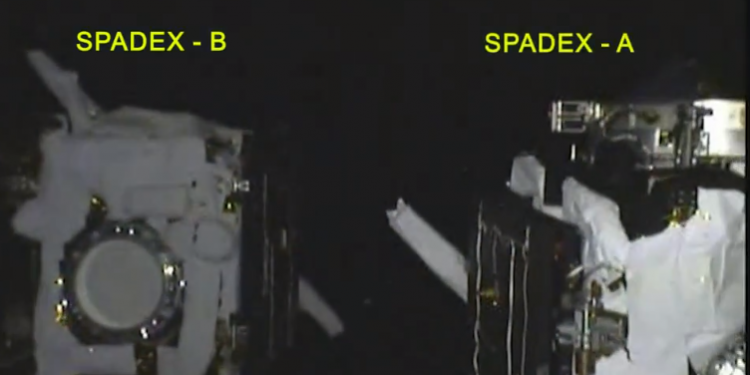Bengaluru: The two Space Docking Experiment (SpaDeX) satellites that ISRO is hoping to unite are at a distance of 1.5 km and will be brought much closer January 11, the space agency said Friday.
The SpaDeX space docking experiment has so far missed two publicly announced schedules, January 7 and January 9.
“Spacecrafts are at a distance of 1.5 km and on hold mode. Further drift to 500 m is planned to be achieved by tomorrow morning,” ISRO said in a post on ‘X’.
This announcement came a day after the space agency shared that the drift between satellites that had caused the postponement of the docking experiment for the second time had been arrested and they were put in a slow drift course to move closer to each other.
ISRO successfully launched the Space Docking Experiment (SpaDeX) mission December 30, 2024.
The PSLV C60 rocket carrying two small satellites, SDX01 (Chaser) and SDX02 (Target), along with 24 payloads, had lifted off from the first launchpad of the Satish Dhawan Space Centre in Sriharikota, and about 15 minutes after liftoff, the two small spacecraft weighing about 220 kg each were launched into a 475-km circular orbit as intended.
After the launch, ISRO has been preparing for the docking, which requires multiple steps/stages.
Docking in space is a complex process, which so far has been mastered by only three other countries – the US, Russia and China.
On January 6, a day before the first docking attempt was scheduled, ISRO announced its postponement to January 9, stating that the docking process requires further validation through ground simulations based on an abort scenario identified.
A day ahead of the docking planned on January 9, the space agency had initiated the drift on Spacecraft A (chaser) to move closer from 500 m to 225 m. But shortly after that it announced another postponement of docking, saying that — while making a maneuver to reach 225 m between satellites, the drift was found to be more than expected, post non-visibility period.
According to ISRO, SpaDeX mission is a cost-effective technology demonstrator mission for the demonstration of in-space docking using two small spacecraft that were launched by PSLV. This technology is essential for India’s space ambitions such as Indian on Moon, sample return from the Moon, the building and operation of Bharatiya Antariksh Station (BAS), etc.
In-space docking technology is essential when multiple rocket launches are required to achieve common mission objectives. Through this mission, India is marching towards becoming the fourth country in the world to have space docking technology.
PTI







































